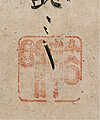Artist
attributed to Tenshō Shūbun
(天章周文; fl. 1414–before 1463)
Catalogue information
Muromachi period, first half of 15th century
Pair of six-panel folding screens; ink and light color on paper
Each screen 153.9 x 274.8 cm (60 5/8 in. x 9 ft. 1/8 in.)
Donated to The Metropolitan Museum of Art, New York by the Mary and Jackson Burke Foundation in 2015
Literature
Tanaka Ichimatsu and Nakamura Tanio 1973, fig. 6
; 1973
Sesshū, Sesson. Suiboku bijutsu taikei (Art of ink painting), 7. Tokyo: Kōdansha.
Murase 1975, no. 32
; 1975
Japanese Art: Selections from the Mary and Jackson Burke Collection. Exh. cat. New York: The Metropolitan Museum of Art.
Takeda Tsuneo 1979, no. 31
; 1979
Chūsei byōbu-e (Folding-screen paintings of medieval Japan). Exh. cat., Osaka Municipal Museum of Art. Kyoto: Kyoto Shoin.
Ford 1985, fig. 9
; Shimao Arata 1989, fig. 16 (detail)
; 1989
“Jūgo seiki ni okeru Chūgoku kaiga shumi” (The taste for Chinese painting in the fifteenth century). [Tokyo] Museum, no. 463 (October): 22–34.
Yamashita Yūji 1993, p. 814, fig. 10
; 1993
“Kakei to Muromachi suibokuga” (Xia Gui and Muromachi ink painting). In Nihon bijutsushi no suimyaku (Currents in Japanese art history), edited by Tsuji Nobuo Sensei Kanreki Kinenkai. Tokyo: Perikansha.
Murase 2000, no. 61
; 2000
Bridge of Dreams: The Mary Griggs Burke Collection of Japanese Art. Exh. cat. New York: The Metropolitan Museum of Art.
Tsuji Nobuo et al. 2005, no. 40.
2005
Nyūyōku Bāku korekushon-ten: Nihon no bi sanzennen no kagayaki / Enduring Legacy of Japanese Art: The Mary Griggs Burke Collection. Exh. cat., Museum of Fine Arts, Gifu; Hiroshima Prefectural Museum of Art; Tokyo Metropolitan Art Museum; and Miho Museum, Shigaraki, Shiga Prefecture. [Tokyo]: Nihon Keizai Shinbunsha.
See also
- Japanese paintings » Ink Painting of the Muromachi and Momoyama Periods
- Screens
- Works of the Muromachi period
This artwork was published as catalogue entry 105 in Volume I of Art through a Lifetime.
Additional details



Signatures
[on each screen] Painted by Shūbun
; inscribed by Hōgen Eishin
[Kano Yasunobu (1613–1685)]
Seals
[on each screen] Hōgen



